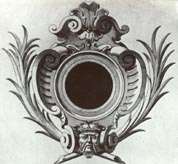Cartouche (design)

A cartouche (also cartouch) is an oval or oblong design with a slightly convex surface, typically edged with ornamental scrollwork. It is used to hold a painted or low relief design.[1]
In Early Modern design, since the early 16th century, the cartouche is a scrolling frame device, derived originally from Italian cartoccia. Such cartouches are characteristically stretched, pierced and scrolling (illustration, left). Another cartouche figures prominently in the title page of Giorgio Vasari's Lives, framing a minor vignette with a device of pierced and scrolling papery cartoccia (see illustration).
The engraved trade card of the London clockmaker Percy Webster (illustration, right) shows a vignette of the shop in a scrolling cartouche frame of Rococo design that is composed entirely of scrolling devices.
Gallery
 Detail showing cartouche on the 1765 de l'Isle globe.
Detail showing cartouche on the 1765 de l'Isle globe. A cartouche framing device on a London clockmaker's tradecard, ca 1760. Such a "card" (engraved on paper) would be pasted into a clockcase
A cartouche framing device on a London clockmaker's tradecard, ca 1760. Such a "card" (engraved on paper) would be pasted into a clockcase

Cartouche over door, Tyska Skolgränd in Stockholm  Portrait of a lady, oil on canvas in painted cartouche, by Garret Morphey
Portrait of a lady, oil on canvas in painted cartouche, by Garret Morphey
See also
Footnotes
External links
| Wikimedia Commons has media related to Cartouches. |